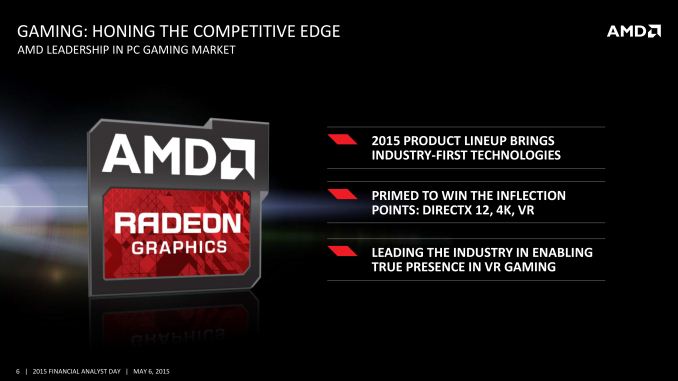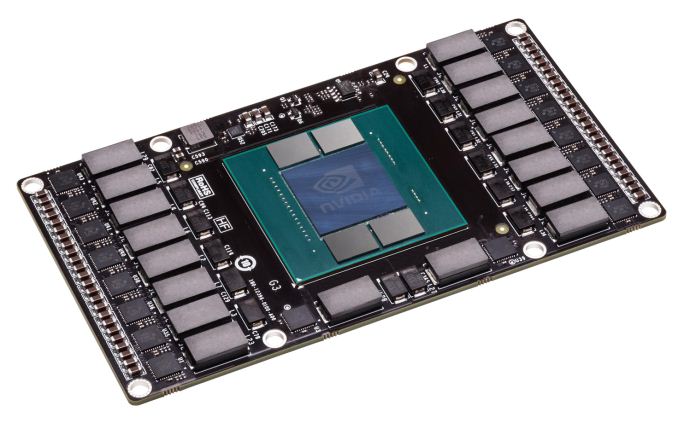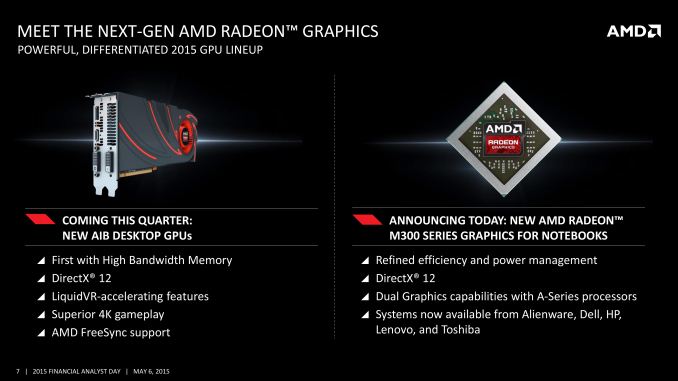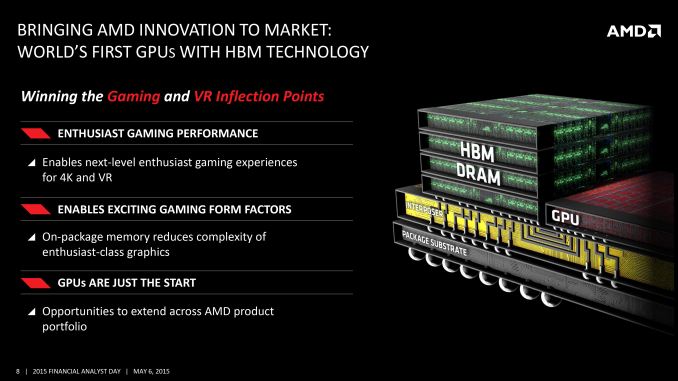AMD To Launch New Desktop GPU This Quarter (Q2’15) With HBM
by Ryan Smith on May 6, 2015 2:22 PM EST- Posted in
- GPUs
- AMD
- Radeon
- AMD FAD 2015

Having just left the stage at AMD’s financial analyst day is CEO Dr. Lisa Su, who was on stage to present an update on AMD’s computing and graphic business. As AMD has already previously discussed their technology roadmaps over the next two years earlier in this presentation, we’ll jump right into the new material.
Not mentioned in AMD’s GPU roadmap but now being mentioned by Dr. Su is confirmation that AMD will be launching new desktop GPUs this quarter. AMD is not saying much about these new products quite yet, though based on their description it does sound like we’re looking at high-performance products (and for anyone asking, the picture of the card is a placeholder; AMD doesn’t want to show any pictures of the real product quite yet). These new products will support DirectX 12, though I will caution against confusing that with Feature Level 12_x support until we know more.
Meanwhile the big news here is that these forthcoming GPUs will be the first AMD GPUs to support High Bandwidth Memory. AMD’s GPU roadmap coyly labels this as a 2016 technology, but in fact it is coming to GPUs in 2015. The advantage of going with HBM at this time is that it will allow AMD to greatly increase their memory bandwidth capabilities while bringing down power consumption. Coupled with the fact that any new GPU from AMD should also include AMD’s latest color compression technology, and the implication is that the effective increase in memory bandwidth should be quite large. For AMD, they see this as being one of the keys of delivering better 4K performance along with better VR performance.
In the process AMD has also confirmed that these HBM-equipped GPUs will allow them to experiment with new form factors. By placing the memory on the same package as the GPU, AMD will be able to save space and produce smaller cards, which will allow them to produce designs other than the traditional large 10”+ cards that are typical of high-end video cards. AMD competitor NVIDIA has been working on HBM as well and has already shown off a test vehicle for one such card design, so we have reason to expect that AMD will be capable of something similar.

With apologies to AMD: NVIDIA’s Pascal Test Vehicle, An Example Of A Smaller, Non-Traditional Video Card Design
Finally, while talking about HBM on GPUs, AMD is also strongly hinting that they intend to bring HBM to other products as well. Given their product portfolio, we consider this to be a pretty transparent hint that the company wants to build HBM-equipped APUs. AMD’s APUs have traditionally struggled to reach peak performance due to their lack of memory bandwidth – 128-bit DDR3 only goes so far – so HBM would be a natural extension to APUs.












146 Comments
View All Comments
chizow - Friday, May 8, 2015 - link
So, momentary moment of PEBCAK. I guess you are going to claim your AMD based systems have never crashed or BSOD'd too right?How come not a single AMD fanboy has answered the simple question whether or not their graphics are at full power/clocks when driving multiple monitors? Still not fixed, right? You'd think AMD would make that a priority given how much emphasis they put on ZeroCore and PowerTune in their slidedecks.
01189998819991197253 - Friday, May 8, 2015 - link
@dragonsqrrlNvidia has had serious HDMI handshake issues for years. That makes it awful for HTPCs.
5150Joker - Wednesday, May 6, 2015 - link
Pretty much what chizow said. Even if AMD could best the Titan X at a cheaper price, I'd still go with the Titan X or 980 Ti. Don't want AMD's half-assed drivers or FailSync that can't even do 144 Hz. Then there's their absymal Crossfire profile support that everyone already knows about.Scannall - Wednesday, May 6, 2015 - link
I really haven't had any problems with AMD drivers for several years now. And only minor problems with NVidia drivers. That's becoming a non-issue. You do yourself a disservice by assuming things don't ever change or improve.Gunbuster - Wednesday, May 6, 2015 - link
Oh case closed, this one persons anecdotal experience ties it all up. No coming soon driver promises for freesync crossfire, no broken enduro and coverup, no broken frame pacing, no me too geforce experience slathered with advertisements, no ugly plastic red branding, no freesync FUD a year after G-Sync, ... Keep the faith AMD fans.Refuge - Wednesday, May 6, 2015 - link
lol same could be said for you.Frame Pacing was fixed, G-Sync may have been out sooner, but if we are talking market share they are both basically almost non-existent, so lets not call that a win so soon.
Optimus was just as broken.
We get it neither are perfect, you just like green more than red. Its fine.
chizow - Wednesday, May 6, 2015 - link
Optimus was broken? Seriously, you're going to have to do better than that if you want to give your posts any credibility. Be honest here, have you ever even used a laptop with Optimus?Gigaplex - Wednesday, May 6, 2015 - link
Typing this post on an Optimus laptop right now. Yes, it was broken at one point. Yes, it mostly works fine these days, unless you're a Linux user where it still causes major headaches.chizow - Wednesday, May 6, 2015 - link
What was broken about it? I've used Optimus since it was introduced in 2010, and while there were some app-specific issues that were addressed with context menu launchers, overall the switchable graphics aspect worked seamlessly. The same cannot be said of Enduro, even today.Refuge - Friday, May 8, 2015 - link
Yes, Optimus was broken and caused a rather weird variety of crashes, performance issues, etc. I honestly place blame mostly on simple miscommunication between nVidia and OEM's because a lot of the problems I was seeing at first were simply related to OEM firmware not playing properly with the Optimus drivers.But its been fixed for quite some time now just like Gigaplex said. Just making the point that things do change, and things do get better.